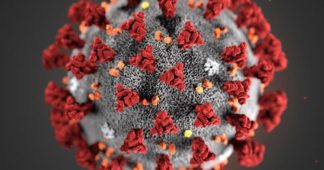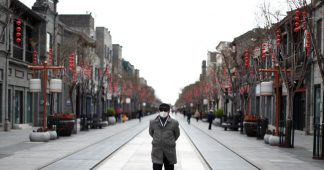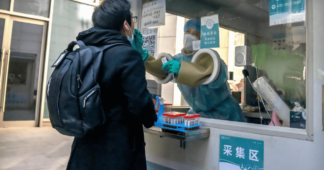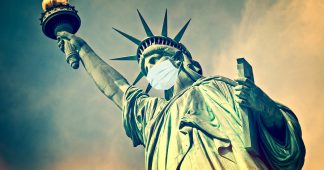Originally published: Multipolarista
by Joe Scholten (February 1, 2022 )
The People’s Republic of China has a population of more than 1.4 billion people, yet has had fewer than 6,000 Covid-19 deaths in the entirety of its territory. The Western press corps insists this is a bad thing.
The New York Times published an opinion piece on January 25 titled “China’s Zero Covid Policy is a Pandemic Waiting to Happen.” In this article, the authors argue that the pandemic will inevitably become endemic, and that the Chinese policy of eradicating Covid has “set the nation up for disaster.”
This proposal made in the New York Times opinion page is lunacy. In the two weeks leading up to the opinion piece, there were two days in which the United States saw more than a million daily Covid cases (January 18 and 24). From January 4 to 31, the US did not have a seven-day average below half a million cases.
As of February 1, more than 885,000 people in the United States have died of Covid-19, and there have been more than 75 million confirmed cases.
By contrast, China has had a total of 137,000 cases and 5,700 deaths in the entirety of Chinese territory – with just 4,636 deaths in the mainland, 213 deaths in Hong Kong, and 851 deaths in Taiwan.
This is despite the fact that China’s population is four times the size of the United States’.
The total number of cases China has had in the entire pandemic has been exceeded by the US’ seven-day average since December 20, 2021. The last date the seven-day average of deaths in the United States sunk below 1,000 was August 22, 2021.
The average number of deaths in the US in single-week periods has exceeded the deaths occurring in China from the pandemic every week since August 2021, save for a single week from late November to early December.
And why have the differences between these two countries been so stark? It is not magic; it is policy.
How China stopped the spread of Covid-19
The cause of these massive discrepancies between the People’s Republic of China and the United States ultimately comes down to the widely disparate responses by the state and private sector.
The British Medical Journal (BMJ), a peer-reviewed publication of the British Medical Association, has released a series of articles analyzing the Chinese government’s Covid-19 containment strategy, and lessons that can be learned from it.
In short, the main features of Beijing’s successful pandemic control were extensive testing, contact tracing, and rigid but targeted quarantines – methods that have been bungled or outright rejected by US officials.
Chinese contact tracing for example, involves QR codes installed on popular mobile apps, such as Alipay and WeChat. These apps are used by a strong majority of Chinese people, and process more than 90% of mobile payments in China. They are required for entry into many public spaces, such as movie theaters, malls, or transportation.
These QR codes have specific colors assigned to reflect users’ status: green corresponds to unexposed and uninfected; yellow means Covid-19 exposure in a certain proximity; red signifies confirmed infection or close exposure. Yellow and red codes alert other users of their exposure, requiring quarantine and/or multiple negative tests.
This tool allows public-health officials to track exposure patterns, and retroactively test individuals who were exposed, preventing large, uncontrolled spread of the virus and instigating localized quarantines when China encounters new cases, effectively cutting off the transmission of the virus before it balloons out of control.
Why the United States failed to contain Covid-19
By contrast, the United States has no nationwide contact-tracing system. Local contact tracers work for extremely understaffed and underfunded agencies which lack the resources and infrastructure needed to reach those who are exposed.
US states like Missouri (where the author of this article resides) have seen government officials demand that “local public health agencies and school districts… rescind and cease enforcement and publicizing of public health orders, mask mandates, quarantine orders,” claiming “public health authorities and school districts have gone unchecked.”
In states like Texas, the government has made contact tracing entirely optional, even when students test positive for Covid-19. Supporters of this policy claim that opposition to these measures is to “protect privacy” – but this didn’t stop government authorities from using cell phone location data to track down, detain, and deport undocumented immigrants during the pandemic.
The US government will happily use these mass-surveillance measures to hound people living paycheck to paycheck, but will obstinately refuse to use those tools for public good.
Why China succeeded with lockdowns while the US failed
Pandemic policies extend beyond just contact tracing; they also involve the sporadic use of lockdowns. The rationale for lockdowns is that a temporary cessation of large gatherings of people in spaces, excluding essential workers, limits possible transmission of the virus.
The US had temporary stay-at-home orders in individual states, but these lasted for limited periods of time, were full of loopholes, and were never deployed again as the situation deteriorated.
These loopholes weakened the effectiveness of the lockdown, allowing large gatherings in churches, for example.
During the deadliest wave of the pandemic in the United States, some municipalities permited indoor dining with limited capacity and curfew.
These could hardly have been called “lockdowns”. They were exercises in security theater, with loopholes that needlessly enabled the spread of the virus, prolonging the pandemic.
Ironically, these half-measures also ended up putting restrictions on North Americans for much longer than they were imposed on people in China, who were able to quickly go back to their normal lives when the virus was contained.
The reality is simply that US authorities were much more concerned with re-opening businesses and forcing people to go back to work. And corporate lobbyists made sure that even these milquetoast half-lockdowns would not be considered again.
It is true, it must be acknowledged, that these half-lockdowns did bring social costs. Millions of North Americans fell behind on rent. Millions more lost their jobs. Federal aid was distributed haphazardly and slowly, and there was not nearly enough of it.
Cuts to unemployment benefits that ended in 2021 are projected to increase poverty in the US and lower wages by an estimated $144.3 billion, according to the Economic Policy Institute.
But these very real costs of the half-lockdowns in the United States were largely a product of the government refusing to spend what was necessary to support and protect its population. Instead, the US government left Covid-19 response to the private sector, outsourcing policy-making and implementation to for-profit companies, and effectively telling citizens to pull themselves up by their bootstraps.
By contrast, in China, the state invested significant resources to meet the needs of its people during the largest public health crisis in a century.
The Chinese government offered generous rent alleviation policies. Hard-hit cities in Hubei province even received six months of rent-free residential living.
Unlike in the United States, where the average insured overnight hospital stay costs roughly $11,700, hospitalization is free or very inexpensive in China – another major factor in Beijing’s ability to contain Covid-19.
The Chinese government has additionally subsidized consumer spending with vouchers, to bolster the economy against the worst effects of the pandemic, and to ensure that citizens don’t worry about slipping into poverty.
In cities like Qingdao, all 9 million residents were tested in just five days. The government used a temporary targeted quarantine, after a handful of cases emerged in the city from overseas.
The policies worked: Qingdao saw no fatalities, avoided a widescale lockdown, and saw life back to normal in the entire city within a few weeks.
Quarantining those who were exposed and aggressively tackling cases as soon as they were detected saved lives and ensured the economic costs to society as a whole were minimal.
The results of Beijing’s Covid-19 policies, purely in economic terms, are stark. China was the only major economy which saw GDP growth in 2020. In 2021, China’s GDP grew by an impressive 8.1%, with per capita GDP increasing as well.
Beijing also managed to address infrastructure and environmental goals during the same period.
The Chinese high-speed rail network expanded to include 75% of all Chinese cities with a population of half a million or higher by the end of 2020. That number increased further in 2021.
Meanwhile, half of Chinese energy is forecast to come from non-fossil fuel sources by the end of 2022.
China’s Covid-19 containment is a success story
It is clear that the Chinese approach to the Covid-19 pandemic has worked. Cases are low; deaths are even rarer; the economy has been stable, despite a pandemic raging around the world; enormous public projects have been able to continue as planned without substantial interruptions.
By contrast, the United States’ policy has seen tens of millions get infected, a death toll greater than its own Civil War, and the continued immiseration of millions of working people who struggle to make ends meet, while their government has effectively left them to die as a pandemic rages.
It is madness to suggest – as the New York Times opinion section has – that China should emulate the North American model.
But the newspaper’s op-ed “China’s Zero Covid Policy is a Pandemic Waiting to Happen” is also insidious in how it mischaracterizes Beijing’s strategy.
The authors argue that Chinese “vaccines are not providing adequate protective immunity to a citizenry that lacks natural immunity through infection,” warning that if “millions need care the hospitals will be quickly overwhelmed.”
The problem with this argument is that obtaining natural immunity requires catching Covid. This isn’t a policy to end the pandemic; it’s a recipe for dangerous variants.
As prominent scientific experts and medical institutions have warned, the spread of the virus throughout the population increases the risk of new variants, a problem countries in the Global South have highlighted in their demands for vaccines.
In March 2021, India and South Africa proposed a waiver for the World Trade Organization’s Trade-Related Aspects of Intellectual Property Rights agreement (TRIPS). This would allow for certain exceptions to be made to copyright laws, enabling less wealthy Global South nations to develop generic Covid-19 mRNA vaccines.
The Peoples’ Republic of China saw that this measure could be an important step to ending the pandemic. Foreign Ministry spokesman Zhao Lijian said, “China fully understands and is supportive of the developing world’s demand for an IPR waiver for COVID-19 vaccines”.
The United States and European Union, on the other hand, blocked this proposal. They were more concerned about maintaining corporate profits than protecting global health.
Absent universal vaccination, ensuring as few people as possible get Covid-19 is an important goal. Uncontrolled spread of Covid, like in the United States and Brazil, can lead to new variants, as the world saw in India.
If a new variant combines the virulence of the Delta variant with the transmissibility of Omicron, a frightening stage of the pandemic could follow – a scenario that some medical experts fear may become reality with the current Covid strategy in the US, which had a higher number of hospitalizations in January 2022 than it did during the worst stages of the pandemic in 2021.
China has handled the pandemic like a responsible global actor. It has ensured that, when Covid outbreaks happen, rapid large-scale testing occurs. Popup labs in the city of Xi’an, for instance, were able to test 5 million people per day.
On a domestic front, China’s policy of mass testing and containment has prevented a virus from spreading uncontrolled through the world’s most populated country, preventing a new variant from emerging there.
And when it comes to vaccination, Beijing has again proven to be a global leader.
The United States hoarded vaccines in the early stages of the pandemic, allowing hundreds of thousands to go to waste, while right-wing politicians literally applauded at their community’s low vaccination rates.
China, on the other hand, was at work delivering more than 1.38 billion doses around the world. Beijing ensured that other nations were not left behind, helping to prevent the rise of new variants.
The United States had delivered just one-quarter the number of vaccines China had as of January 2022.
The Chinese Covid-19 response is not a disaster waiting to happen, as the New York Times has claimed. Rather, Bejing’s model averted the disastrous consequences seen the United States.
China used sensible public-health measures to prevent the spread of the virus. It employed limited, targeted, and effective lockdowns to stamp out the virus when detected. It met the needs of its population with generous social spending. It sent much-needed vaccines around the world, while ensuring a high rate of domestic vaccination.
And today, China is fighting to help fellow nations in the Global South free themselves from the neocolonial grip of international IP laws, amplifying the call for the right to manufacture generic versions of vaccines.
Maybe if the United States and its media class had studied China’s example, instead of being so quick to condemn it, they could have learned something – and more than 885,000 North Americans may not have tragically lost their lives.
We remind our readers that publication of articles on our site does not mean that we agree with what is written. Our policy is to publish anything which we consider of interest, so as to assist our readers in forming their opinions. Sometimes we even publish articles with which we totally disagree, since we believe it is important for our readers to be informed on as wide a spectrum of views as possible.











